Ownership is important to many people at work because it allows them to feel a sense of control and responsibility over their work and their contributions to the organization. Ownership can also provide a sense of accomplishment and pride in the work that one does, which can be rewarding and fulfilling. When people feel that their work is valued and that they have a meaningful role to play in the success of the organization, they may be more likely to feel invested in their work and to be motivated to perform at their best.
Especially that last aspect, motivation, has got me thinking a lot about ownership lately. You can be in a position where you have a lot of ownership, but still feel frustrated and unmotivated. So while it has a significant impact, it can still be difficult to articulate exactly how it impacts motivation. One thing is certain, the number of articles that show up on Google related to ownership at work shows that there is significant interest in this topic.
This article explores a visual representation of this concept to make it easier to reason about it and discuss the topic.
The ownership pendulum
You could see ownership as the ability to make strategic decisions or in simpler terms, the ability to go in a certain direction. This could go from very high-level strategic decisions such as the company’s business model or lower-level strategic decisions such as which programming language to use to solve a specific problem.
Every company has some sort of hierarchy, with the CEO at the top, managers in the middle and team members at the bottom. This can be visualized using pendulums like this:
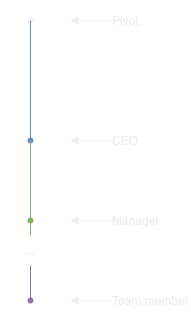
Each level has some wiggle room depending on the length of the pendulum’s arm. When applying this to a single decision at the level of the CEO wanting to go for Strategy X, it would look something like this:
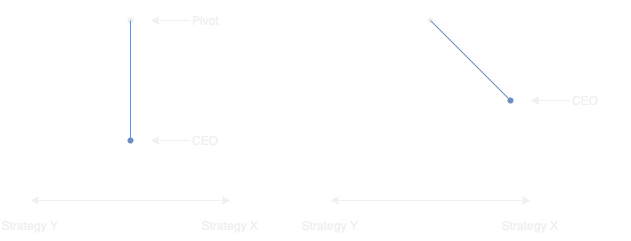
Each subsequent level will use the previous level as its pivot. Each setup of pendulums will lead to a different situation that might seem familiar. The remainder of the article will go through a couple of those setups.
Of course, decisions aren’t in the form of something against the opposite of something and decisions are very often interconnected, making it way too difficult to visualize. The focus is on how somebody in a certain position can influence decisions.
Basic examples of the pendulum
Up next are three basic examples of what the pendulum could look like in a different kind of company: an enterprise and a startup. For now, the focus is on the amount of ownership and the number of people involved, not on strategic direction.
The old-style hierarchical enterprise
This is traditionally a structure with a lot of layers between team members and the CEO. This is not necessarily a bad thing though, for some companies it works very well.
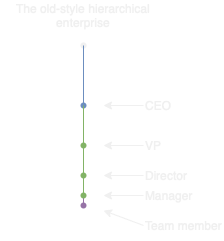
The downside is that as a team member, you have a very limited amount of ownership (you know there’s not much left if I can’t even use straight arrows in the image anymore). There is not much opportunity to truly change the company unless you are at a higher level. It’s also not possible for a manager to give much more ownership, because their ownership is often rather limited as well.
This kind of structure also means that if there is a large-scale change at the top, you have no other option than to just follow along. There is no room for adjusting at your own pace. This might also be the reason why people in that situation can feel like a number and very often resist large changes because they feel thrown around instead of being considered in the whole situation.
For some people, this can also be great. The next step in their career is a step up on the ladder, which will have very predictable changes.
The nimble startup
The opposite side of the spectrum is the nimble startup where there is a limited number of steps between team members and the CEO.
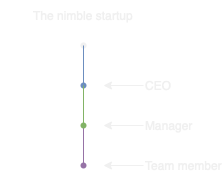
A company with this structure gives a lot of ownership to everyone. This might also simply be required: when there is a limited number of employees, some of them might need to step out of their roles to keep the situation under control.
For me personally (and I think for many others as well) this could be great, but it’s a high-risk, high-reward situation. You get a lot of freedom and the ability to make a real impact, on the other hand, you might get a lot of freedom in work that you don’t want to be doing.
The micromanager
Everyone knows the idea of a micromanager, somebody who is constantly looking over your shoulder and tightly controls what you do and how you do it.
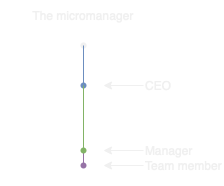 Micromanagers are bad for a whole lot of reasons: lack of autonomy, lack of trust, limited learning opportunities,… But that is not all, looking at it using this analogy shows another problem. You can’t even go to the level above your manager, because they will not be concerned with the details you are talking about. They are thinking at too high of an abstraction level. Of course, if there’s a very good person at that higher level, they will try to help you out, but it most likely won’t be super concrete, which can be frustrating as well.
Micromanagers are bad for a whole lot of reasons: lack of autonomy, lack of trust, limited learning opportunities,… But that is not all, looking at it using this analogy shows another problem. You can’t even go to the level above your manager, because they will not be concerned with the details you are talking about. They are thinking at too high of an abstraction level. Of course, if there’s a very good person at that higher level, they will try to help you out, but it most likely won’t be super concrete, which can be frustrating as well.
Conclusion
These were a couple of examples of the pendulum ‘in action’. Ownership is important, but a lot of ownership doesn’t equate to happy employees and there could still be a lot of friction. Maybe having a way of visualizing this enables a conversation about your current situation, who knows?
Maybe I can revisit this idea because many more situations could be explained using this analogy.